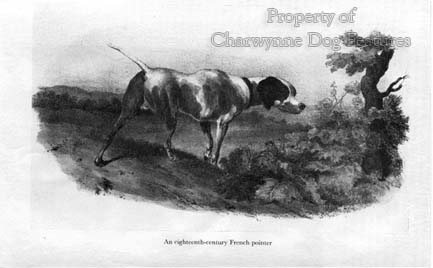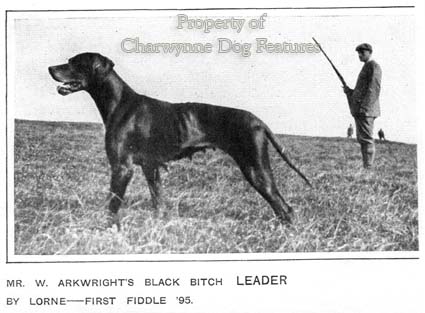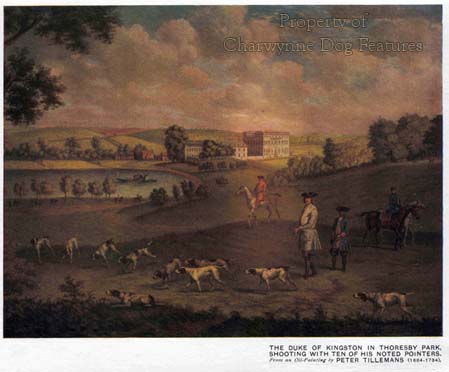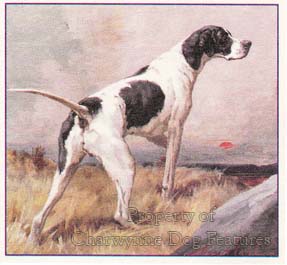453 Pointing the Way
POINTING THE WAY
by David Hancock
 Just as mastiffs have an impressive magnanimity and setters have a certain style, so the pointing breeds have elegance, a definite gracefulness. They never seem to possess the sheer effusiveness of the spaniel breeds, the earthy warmth of the retrievers or the eternal impudence of the terriers. Pointers have their own characteristics; I swear that our native pointer can look decidedly disapproving if their natural dignity isn't respected. They demand stylish handling in the show ring and in the field. My own favourites are the all-black ones, sadly not so common these days. But does your Pointer have the retrieving instinct and did the breed originate in Spain?
Just as mastiffs have an impressive magnanimity and setters have a certain style, so the pointing breeds have elegance, a definite gracefulness. They never seem to possess the sheer effusiveness of the spaniel breeds, the earthy warmth of the retrievers or the eternal impudence of the terriers. Pointers have their own characteristics; I swear that our native pointer can look decidedly disapproving if their natural dignity isn't respected. They demand stylish handling in the show ring and in the field. My own favourites are the all-black ones, sadly not so common these days. But does your Pointer have the retrieving instinct and did the breed originate in Spain?
I do not believe that the Pointer of Britain originated in Spain or indeed that pointers as a functional type of dog sprang from there, as is usually claimed. It is important though to clarify the nomenclature being used. There are French, Italian, Danish, Portuguese, Spanish and British pointers, with several different breeds of pointer within some of those countries. A pointer is a type of short-haired (usually), houndlike bird-dog, rather than one breed. It is misleading and inaccurate, and perhaps overly nationalistic, to dub the Pointer of Britain as the pointer, despite its deserved world-wide reputation.
It is worth a study of the wealthy and well-informed William Arkwright's classic work 'The Pointer and his Predecessors' of 1902 on the question of the origin of our native Pointer. Despite the time and money he clearly spent searching not only Spanish but other continental archives too, he could produce no evidence of a Spanish origin for the breed. But the historical evidence which can be produced demands the most careful scrutiny before definitive statements can be made.
The Edwardian writer, Rawdon Lee, accepts that the French had their own pointers before the Spanish Pointer was introduced into Britain at the beginning of the 18th century, going on to state that in the latter part of this century: "Pointers far removed from the imported Spanish dog in appearance, were not at all uncommon in England and they could easily have been brought over from France." The French have of course long maintained a smaller breed of pointing dog, the Braque Francais de petite taille. 
Richardson, writing in 1847, describes seeing Italian Pointers in Scotland, only about a foot high, but remarkably staunch with superb noses. In his 'The Art of Shooting Flying' of 1767, Page remarks: "Pointers. - As nothing has yet been published on these dogs...I am inclined to think that they were originally brought from other countries, though now very common in England." I am inclined to think they were originally brought from other countries too, France, Italy and Spain, with distinctive types from each country of previous development. The modern English Pointer is much more like the French Braque St. Germain than the old Navarro and Burgos Pointers from Spain and the modern Bracco Italiano.
Arkwright's Pointers had considerable influence in the making of today's dog, his all-black Pointer coming from the Greyhound cross and an increasing number of contemporary dogs, both in Europe and America, exhibit the tucked-up loin, the tighter lips and low-set tail from this Greyhound blood. The Pointer of Britain has the eye and the eyesight of a sighthound, certainly no trace of the sunken eye of the scenthound breeds. In temperament too, the Pointer has more in common with the cool, aloof, reserved, rather introverted Greyhound than the gregarious, much more extrovert and certainly noisier Foxhound.
Greyhounds were used in medieval falconry, often working in tandem with the 'setting dogs'. 
The French use the term 'chien d'arret' to embrace both epagneuls (their equivalent of our setting dogs) and braques (their word for pointing dogs). The word epagneul is usually said to come from the word espagnol but more likely came from an Old French verb s'espanir, to flatten or 'set', with braque coming from an equally old verb braquer, to aim. The words braque and pointer therefore have the same functional derivation. The Braque Francais, or French Pointer, is an ancient breed, according to the French: "...undoubtedly the oldest breed of pointer in the world. It has been the origin of nearly all the continental and British short-haired 'setters'." No concession to any Spanish origin there!
The Auvergne Pointer comes from the old Pyrenean braque and the Gascony Pointer. The German short-haired Pointer however is admitted to have both English and Spanish Pointer blood. Drury, in his 'British Dogs' of 1903, notes that the first pictorial record of the pointer in Great Britain is the Tillemans painting of the Duke of Kingston with his kennel of Pointers in 1725. He commented that the latter were the "same elegant Franco-Italian type as the pointing dogs painted by Oudry and Desportes at the end of the 17th century."
Arkwright himself wrote that: "...the French were the chief admirers of the Italian braque...And after a time, though the heavier type of their own and the Navarrese braque still survived, it was quite eclipsed by the beautiful and racing-like Italian dogs with which Louis XIV and Louis XV filled their kennels." This ability of the domestic dog to indicate unseen game by standing in a frozen posture staring hard at it has been utilised since ancient times. The Greeks identified a breed of dog in Italy, called the Tuscan, which was covered with shaggy hair and would actually point to where the hare lay hidden, perhaps the ancestor of the Spinone. Wolves have been known to display the same capability however and many non-sporting breeds of dog have also demonstrated this instinctive trait. 
This scenting skill, supported by the classic pointer stance, has been of great benefit in the shooting field, especially in the days when 'walked up' as opposed to driven game was the favoured style. In the quest for improved scenting powers, the outcross to the Foxhound was made and some experts like William Humphrey, of Wind'em pointer fame, have claimed to be able to spot Pointers with Foxhound blood in them from their tendency to seek ground scent as opposed to air scent. This is the expected penalty from using tracking dog blood.
Professor J.M.Beazley has traced the origin of our modern English Pointers back to seven discrete families and shown how these original family groups led to the emergence of two main lines of descendants from 1840 to 1980. This may indicate a small gene pool but that doesn't mean the sealing of type forever more. Genes act randomly and type has to be actively sought. A decade or so ago, I was concerned to see the judge's critique for the Southern Pointer Club's Spring open show, which read: "I was dismayed to find such a wide divergence in type and size. Many showing foxhound or greyhound characteristics, foxhound feet with the characteristic 'knuckling over' at the knee, round greyhound-like toplines...many good dogs and bitches had their chances lessened by soft thigh and shoulder muscle and little development of the second thigh, so essential to get the drive off the hock. Pointers are all about action...if the drive and activity is missing, so is the great essential of the breed."
A few years later, the Border Union show Pointer judge wrote in his critique: "I have been showing Pointers for the past 20 years and awarding CCs for the last seven years and it distresses me to see the way that the overall quality of this breed I love has declined. During the 70s and 80s the strength in depth of the breed was to be admired -- sadly this is not now the case...Too many exhibits are upright in shoulder, lacking in depth of brisket, lacking in body, bone and muscle and are a long way removed from the breed's main characteristic of being aristocratic, alert with the appearance of strength, endurance and speed." I do hope we retain true type in this admirable English breed. After the running down of so many leading kennels in recent times -- Scotney, Carswell, Blackfield, Cromlix, Segontium and the like, it is important to keep some depth in the breed. Far too many of the best working dogs are being exported, those of the distinguished breeder-trainer-handler Derry Argue for example. It is good therefore to see the dual-purpose dogs of the Crookrise kennel doing well here as well as overseas.
There is something quintessentially English about our native Pointer, with those possessing true breed type deserving the renowned 'Stonehenge's' description in the middle of the last century of them as being "...one of the most beautiful of all our sporting dogs, dividing with the setter the admiration of all those who enjoy the pleasures attending on the use of the gun." I do hope they withstand the dramatic influx of all-rounders from Germany in the last thirty years and continue to draw our admiration in the coming century. But unless the conformation best suited for the shooting field is preserved, I cannot see sportsmen being tempted back to them -- even if they are allowed to retrieve once again!